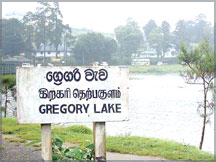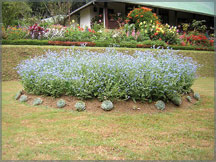A heart beat away from happiness
Once a haven of British planters 'Little England' -
Nuwara Eliya:
'You will find something far greater in the woods than you will find
in books. Stones and trees will teach you that which you will never
learn from masters ' - St. Bernard.
by Rosanne Koelmeyer Anderson
Once a haven of British planters with many old-English bungalows,
unfolding an overwhelming conventional majestic awe, stands 'The City of
Lights' better known as 'Little England' or Nuwara Eliya in the central
hills of Sri Lanka, 6200 feet above sea level.

Nuwara Eliya, discovered by a hunting party led by Dr. John Davy in
1818 and established as a summer retreat in 1828 by Sir Edward Barnes,
the then Governor of Ceylon was the favourite hill station of the
British who tried to create the town into a typical English village. A
typical British village then, and a home away from home for the British
colonialists in the 19th century, we now boast of her majestic grandeur.
Not far off from Colombo, just 160 km drive from the City, of
Colombo, approximately a five hour drive, is the splendour of Nuwara
Eliya's scenic town overlooking the lush green tea bushes, running
streams and cascading waterfalls amidst the cool breeze and beautiful
climate, a tranquil holiday that many locals look forward to especially
during the April holiday season. Sri Lanka's tea-growing capital, is a
cool retreat from the coastal heat and British planters would have
thought the same.
Where the mist kisses the surging green hills; where the waterfalls
whisper to the wind; where the flowers ignite the valleys; where the
colourful butterflies rally around you on the highlands of Sri Lanka,
lives a bit of England, in Nuwara Eliya.

Nuwara Eliya, is the centre of the tea growing industry in Sri Lanka
and is also known as 'Little England' due to its similar climatic
patterns. Blessed with a salubrious climate, the hill station presents a
wide choice of climate and scenery to suit every taste.
The waters of irrefutable purity cascade down from the mountain tops
and flow endlessly revealing a breathtaking cynosure of overwhelming
beauty which makes it hard to imagine that Nuwara Eliya is not far away
from the hot and humid city of Colombo.
Overlooking Nuwara Eliya, the capital of the tea industry is Mt.
Piduruthalagala, the highest peak in Sri Lanka adding colour and glory
to Sri Lanka's rich history. Sri Lanka is also renowned for its tea
industry and its significance of being one of the world's largest tea
exporters.
All credit to James Taylor who was responsible for making Sri Lankan
tea such a wonder in 1851 which made us proud inheritors of a great
invention.
|

Haggala Garden |
The beginnings of the first tea factory has been recorded in fact by
historian D. M. Forrest who quotes a description provided by Taylor's
neighbour, planter E. G. Harding: "The factory was in the bungalow. The
leaf was rolled on tables on the verandah by hand, i.e. from wrists to
elbow, while the firing was done in chulas or clay stoves over charcoal
fires, with wire trays to hold the leaf.
Nuwara Eliya having produced some of the country's best tea over an
extensive period of time; today boasts of the beautifully laid out green
carpets which extend for many miles.
Driving along, right up to Nuwara Eliya you would observe that it is
nothing but tea estates and tea factories, some of them open to visitors
to savour the flavour of the exotic blends of tea available from low to
mid and high grown teas.
Try a bit of the wonder tea which is fast catching on, and believed
to lower cholesterol levels, the power to rejuvenate the skin and
destroy intestinal bacteria, control enzymes producing glucose, suppress
cancer, prevent diabetes and tooth decay and maintain body fluid balance
and blood pressure, more common among foreigners.
The beginning of modern Nuwara Eliya, says G. P. S. H. de Silva, in
his well documented book was essentially the work of the British 'From
its accidental discovery made in 1819 by Dr. John Davy and his gang of
hunters while they penetrated into the mountain territory in pursuit of
elephants' and the official recognition of Nuwara Eliya came about ten
years later when Sir Edward Barnes, as the then Governor of the island,
alive to its importance as a unpolluted station for the troops, took
possession of it and commenced the construction of barracks for his
soldiers, and a bungalow for his own use.
In 1829 Nuwara Eliya was brought into existence as a health resort
with the construction of roads. According to British Colonial
terminology, this was referred to as 'the hill station.'
It was at this time that instructions were issued to trace a road
from Kandy to Nuwara Eliya, which was subsequently undertaken by Captain
Dawson in 1828 but finally, it was Samuel Baker, the famous British
explorer, who discovered the splendour and the serenity of this mountain
resort.
Sir Samuel Baker after having fallen in love with its charm, planned
to make it his home and this section of the country still has some
resemblance of an alien character, and the charisma of old-fashioned
British country side.
The early residents of Nuwara Eliya were mostly planters who
maintained properties in the district and it was Sir J. West Ridgeway
who gave all assistance to improve the area, and before long, the entire
hill sides were dotted with bungalow style houses.
Established as a little corner of England in a foreign land, Nuwara
Eliya's town's colonial past still remains; the grand Hill Club, the
pink brick post office, The Grand Hotel and the jewel in the crown of
Nuwara Eliya, the 117 year old Golf Course which goes very far back in
history.
The tea plantations, golfing, horse riding, boating, hiking and of
course exploring the beauty of the landscaped gardens, waterfalls and
plateaus go beyond description. Exploring the incredible place wouldn't
be a tedious effort as the climate has an average temperature of 10 C
which hardly makes you perspire or feel any exhaustion while exploring
the many attractions the 'City of Lights' has to offer.
Among its many attractions is the Haggala Botanical Gardens about 10
km from the town, the second largest gardens in Sri Lanka with its
charm, cold atmosphere and picturesque beauty and blooming flowers.
The main reason to establish the garden at Haggala in 1861 was
cultivation and promotion of Cinchona and later, the garden was used for
experimentation of tea cultivation in up country and thereafter it was
developed into a botanical garden in 1884.
But, apart from this, going down the annals of Sri Lankan history is
the legend of a famous King of Ceylon, Ravana whose name is remembered
in connection with the epic love story with Sita, a beautiful queen of
India, for whom he made a pleasure garden and hid her in the vicinity of
the botanic in the region where the Haggala garden spreads today. The
area was named Sita Eliya in honour of Queen Sita, and a Hindu temple
was subsequently built close to where she was hidden.
The Haggala Gardens today boasts of rare plants and trees from around
the world, a variety of montane orchids, many of them endemic to Sri
Lanka, a special variety of pines and many varieties of ferns.
The fernery at Haggala is a shady stretch for many a quiet romantic
walk in the shade of the Haggala Rock, shaped like the jawbone of an
elephant, from which the place gets its name. If you have left your
heart in an English garden you will surely find it here amidst Haggala's
Rose Garden and the Orchid House for Orchid lovers which makes Haggala
one of the loveliest contrasts of Lassana Sri Lanka's scenic beauty, an
important visit not to be missed.
Feeling a little languid and wanting to indulge in some sport, move
over to the famous Golf Course in Nuwara Eliya.Established in 1889, the
Nuwara Eliya Golf Course situated right next to the Grand Hotel, is one
of the most picturesque 18 - hole golf courses in Asia to play the game
as Mark Twain, famously defined 'as a good walk spoiled; even if you
played with a croquet mallet in a blinding grain storm, golfing in a
country blessed with such achingly beautiful scenery could only be an
edifying experience,' a game that dates back to the 19th century played
more commonly among an elite few in Sri Lanka.
A sight to see the splendour of the Lakshapana Falls off Nuwara Eliya,
on the Kandapola road where beer is brewed from the water of the stream,
is another interesting explore.
The brewing of beer was incidentally started in Nuwara Eliya by Sir
Samuel Baker in 1881 at Lover's Leap and a visit to the brewery is
interesting for the brewery is one of the finest in the island and has
been in business since 1884.
The shift to the explicit Devon Falls named after Devon, a pioneer
coffee planter west of Thalawakelle which has special parking and
viewing is yet another breathtaking sight of nature's beauty unfolded in
the misty mountains of our beautiful island, Sri Lanka.
Some of the other places of interest are The Race Course where many
drive up to witness the heart- throbbing racing events through out the
year which is a show of high fashion captured by many newspapers, or a
visit to Horton Plains, Sri Lanka's highest plateau paradise for nature
lovers, The famous Lake Gregory where you can avail yourself of a boat
ride, a romantic get away, the Old Tea Factory turned into a hotel at
Kandapola, the outstanding British colonial style Grand Hotel, St.
Andrew's, Windsor Hotel which tells us of how life may have been for the
masters of our land then and last but not least, the most popular hill
trail in Sri Lanka to 2200m above sea level, not simply a trail but a
pilgrimage to a summit mounted by many a traveller, religious beliefs
apart, when the summit is relatively dry between December and April to
the popularly known Adams Peak or Sri Pada.
So much for the best of Nuwara Eliya which will leave nostalgic
memories of bygone, days to some, while a yearning to be pampered by the
cool of 'Little England' to others or an ideal hide out for honeymooning
couples over many, many years or to those romantics a life with a
difference that still lingers in the hearts of many a traveller.
[email protected]
|
